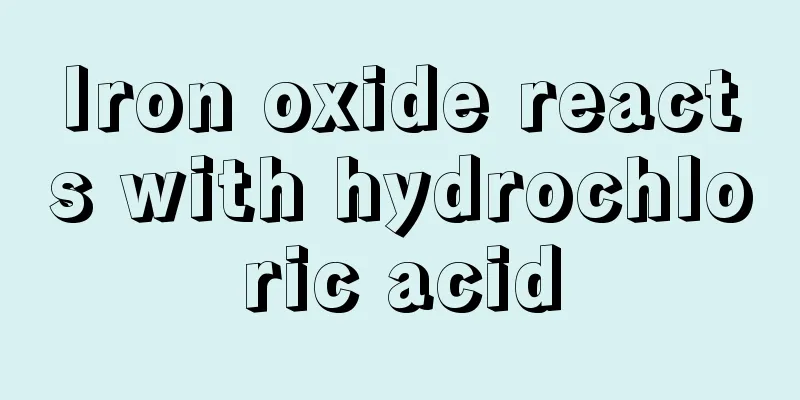Iron oxide reacts with hydrochloric acid

|
Hydrochloric acid is an aqueous solution of hydrogen chloride and is a commonly used industrial raw material. Hydrochloric acid is composed of a hydrogen ion and a chloride ion. Hydrochloric acid is a strong acid that can react with oxides as a reducing agent and can reduce oxidized metals. In industry, hydrochloric acid is often reacted with iron oxide to improve the accuracy of ironmaking. It can also be used to treat rusty iron or steel by removing rust from the surface of iron or steel. In addition, hydrochloric acid is highly corrosive. Next, let’s take a closer look at the precautions when using hydrochloric acid for industrial purposes. Hazard prevention Operational matters When using hydrochloric acid, personal protective equipment should be worn. Such as rubber gloves or polyvinyl chloride gloves, goggles, chemical-resistant clothing and shoes, etc. to reduce the risk of direct contact with hydrochloric acid. Operate in a closed environment and pay attention to ventilation. The operation should be mechanized and automated as much as possible. Operators must undergo special training and strictly abide by operating procedures. It is recommended that operators wear self-priming filtering gas masks (full-face masks), rubber acid-resistant and alkali-resistant suits, and rubber acid-resistant and alkali-resistant gloves. Keep away from flammable and combustible materials. Prevent vapors from escaping into the workplace air. Avoid contact with alkalis, amines and alkali metals. Be careful when handling to prevent damage to the packaging and containers. Equipped with leakage emergency treatment equipment. Empty containers may contain hazardous residues. Acid mist treatment During the use of hydrochloric acid, a large amount of hydrogen chloride gas is generated. The suction device can be installed next to the container, and then used in conjunction with fans, acid mist purifiers, air ducts and other equipment and facilities to discharge the hydrochloric acid mist for outdoor treatment. Acid mist inhibitors may also be added to hydrochloric acid to inhibit the volatilization of hydrochloric acid mist. Leakage emergency treatment Emergency treatment: Quickly evacuate people from the leaked contaminated area to a safe area, isolate it, and strictly restrict entry and exit. It is recommended that emergency response personnel wear self-contained positive pressure respirators and acid- and alkali-resistant work clothes. Avoid direct contact with leaking material. Cut off the source of the leak if possible. Small spills: Mix with sand, dry lime or soda ash. It can also be rinsed with plenty of water, diluted with clean water and put into the wastewater system. Large-scale leakage: build dikes or dig pits to contain the leakage. Use a pump to transfer to a tank truck or special collector for recycling or transport to a waste disposal site for disposal. Firefighting measures Dangerous characteristics: Can react with some active metal powders to release hydrogen. It can produce highly toxic hydrogen cyanide gas when it comes into contact with cyanide. It reacts with alkali to neutralize and release a large amount of heat. It is highly corrosive. Fire extinguishing method when hydrochloric acid is present: neutralize with alkaline substances such as sodium bicarbonate, sodium carbonate, slaked lime, etc. Large amounts of water can also be used to extinguish the fire. First aid measures Skin contact: Take off contaminated clothing immediately, rinse with plenty of running water for at least 15 minutes, apply weak alkaline substances (such as alkaline water, soapy water, etc.), and seek medical attention. Eye contact: Immediately lift the eyelids and rinse thoroughly with plenty of running water or saline for at least 15 minutes. Seek medical attention. Inhalation: Move quickly away from the scene to fresh air. Keep the airways open. If breathing is difficult, give oxygen. If breathing stops, perform artificial respiration immediately. Seek medical attention. Ingestion: rinse mouth with plenty of water, swallow a large amount of raw egg white or milk (do not take baking soda or other medicines), and seek medical attention. [35] Safety Signs Hydrochloric acid is highly corrosive and the container needs to be marked with a corrosive symbol. |
<<: Silver nitrate reacts with hydrochloric acid.
>>: What to do if double eyelids grow after full incision
Recommend
Acclimatization is a disease
When some people go to a foreign country, they wi...
Should I use toothpaste to brush my implanted teeth? What is the correct way to brush my implanted teeth?
Many people have problems with their teeth. A com...
What are the skin care steps? Reveal the correct steps for you
Beauty and skin care are very important things fo...
Does lung cancer cause chest and back pain? Most people do
Lung cancer patients will experience chest and ba...
What is the reason why the mouth is easily inflamed?
If the mouth is easily inflamed, the symptoms of ...
What to do if the inner thigh muscle is strained
Nowadays, more and more people are under great pr...
What to do if TSH rises after hemisection of thyroid cancer
Hemisection of thyroid cancer means that after he...
Treatment of thyroid nodule calcification, these situations require surgery
Thyroid calcification is usually not life-threate...
Radical nephrectomy should not blindly perform lymph node dissection
The prognosis of renal cancer mainly depends on t...
What is the fastest way to remove paint smell?
Paint is the most commonly used decoration produc...
Postoperative care measures for patients with rectal cancer
After rectal cancer patients undergo colostomy, i...
The early symptoms of skin cancer will become erosive ulcers
Early symptoms of skin cancer cause deformity and...
Where does endometrial cancer metastasize from
Endometrial cancer, also known as uterine body ca...
How is breast cancer diagnosed
The diagnosis of breast cancer must be based on h...
10 emotions that change your life
1. Thanks This is probably the most studied posit...









